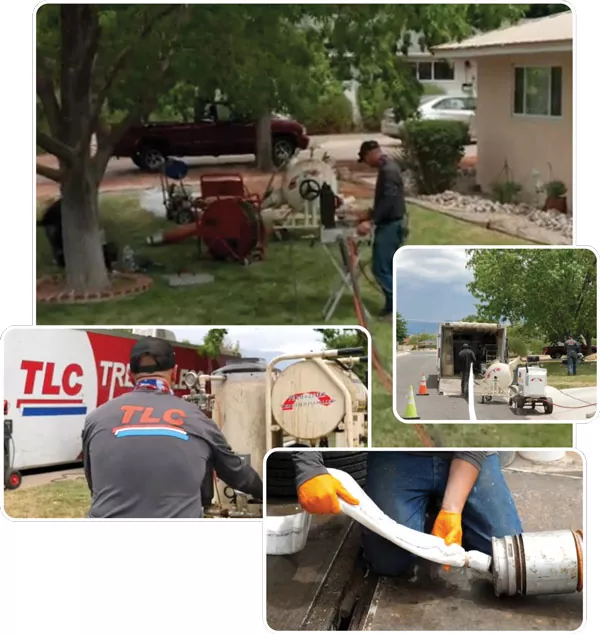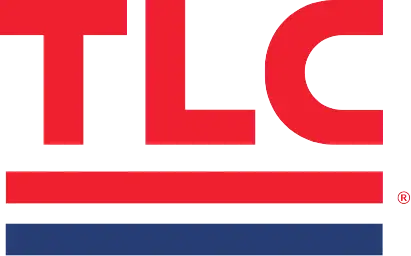Pipe Lining Contractor in Albuquerque
What is trenchless pipe lining?
Underground pipes carry water into your home and sewage out. A leak in the pipes can mean sewage backups or extremely high water bills. Plumbers used to have to dig up your yard to repair these underground pipes. However, with new technology our plumbers can use trenchless pipe lining or pipe bursting to repair these pipes with little to no damage to your yard, saving you time and money. Trenchless pipe lining is also known as cured-in-place-pipe (CIPP).
Trenchless pipe lining is when a licensed plumbing contractor like TLC uses a flexible, resin-coated tube to line your existing pipe. Once cured, this tube becomes your new pipe, but without the leaks.
Sewer line problems we solve:
- Aging sewer lines
- Calcification removal in sewer lines
- Root intrusion
- Pipe shifting from ground movement
Sewer & Drains
Old Pipes Become New Again
Free on-site estimates call now (505)761-9644 or schedule service online.
TLC Pipe Lining Service
We specialize in a variety of services that allow us to inspect, clean, repair, replace and install residential and municipal pipes with speed and efficiency.
Hydro Excavation
Lorem ipsum dolor sit amet, consectetur adipiscing elit. Aenean diam dolor, accumsan sed rutrum vel, dapibus et leo.
Cured-In-Place-Pipe (CIPP)
A pipe liner is inserted into the old pipe and then inflated and cured in place sealing itself to the old pipe creating a new pipe.
Manhole To Manhole Pipe Lining
Pipe lining can be used to line municipal sewer lines by inserting the new pipe through manholes.
Robotic Cutting
TLC’s experts insert a robot into the sewer or water line and navigate it to cut new drain line access after new pipes have been inserted.
Jetting And Descaling
Hydro Jetting using power high water pressure sprayer that is inserted into drain line to remove calcium buildup and clean pipes.
Cleaning And Video Inspections
TLC’s Sewer & Drain team are experienced in drain cleaning and drain video inspections for homes and businesses.
Pipe Lining Process
Step 1) – Video Inspection and Evaluations
First, an initial inspection of the pipe is performed with a high-definition sewer camera. During this process we will measure the linear footage and diameter of your pipes as well as locate and document any problems such as cracks, blockages, tree roots, etc. After the inspection, you are provided with a copy of the video, a not-to-scale drawing of your sewer’s layout, a deficiency report and a proposal to rehab any pipe problems we may have discovered.
Step 2) – Sewer Cleaning and Clearing
Second, the pipes are thoroughly cleaned utilizing hydro-jetting or mechanical methods. This process removes tree roots, blockages and scale buildup in preparation for lining. On occasion, sewer cleaning may be all that is required to remedy pipe problems such as slow drains and blockages.
Step 3) – Liner Installation
After the pipe is cleaned and excess debris is removed, the pipe can now be lined. The felt liner is measured and cut to the dimensions of the pipe such as length and diameter. Then the liner is saturated with a two-part epoxy and inserted into the pipe either by the Inversion Method or the Pull-In-Place Method. An inflatable bladder is inflated inside of the epoxy-saturated liner causing the liner to take the shape of the pipe while it cures in place. After the epoxy has cured, the bladder is removed, and a brand-new pipe is left in place inside of the existing one.
Step 4) – Branch Reinstatements
Finally, after the pipe has been lined, the branch lines that were covered over will have to be robotically reinstated or reopened with our state-of-the-art reinstatement equipment. Robotic reinstatement technology allows us to use one continuous liner from one end of the pipe to the other ensuring that the fittings are protected as well.
Step 5) – Ready For Service
Once cured, the calibration tube is removed, and the sewer flow is returned to your newly lined pipes.
14-Day lead time on permits when in a city street.
The average time to complete is 4 to 8 hours.
Schedule Now
Environmental Benefits of Epoxy Pipe Lining
Cured-In-Place-Pipe (CIPP) is environmentally friendly. The process reduces waste during installation. Less equipment on the job means less energy use and less emissions. Epoxy pipe lining creates no waste for landfills and generates no carbon emissions during development. Lining prevents heavy metals from leaching into drinking water and stops leaks and breaks in sanitary lines that could seep pollution into groundwater. We strive to create the smallest possible part job site and the shortest installation of any small-diameter lining system. Our process is less disruptive, better for the environment and better value for our customers.
PERMA-LINER MATERIAL
Perma-Liner is made from Styrene-free resin. It is used to restore cast iron, clay or PVC lines. The life span of Perma-Liner is 50 years. The products are UPC and ICC-ES listed and meet NSF/ANSI standard 14 certification and quality assurance program.
- The product has been used and trusted since 2002
- The process is 100% trenchless
- This technology can be used on pipes from 2″ – 8″ in diameter
- This “true” inversion method allows the Perma-Liner materials to negotiate 22°, 45° and sweeping 90° angles with ease.
ADVANTAGES OF TRENCHLESS PIPE LINING
As a trenchless technology, lining does not require excavation to rehabilitate a pipeline that is either leaking or structurally unsound. The finished product is a stronger, acid resistant, faster flowing pipe that will last up to 50 years or longer. There is peace of mind to be had in knowing that roots, separated joints, main connections, even no-pipe areas in a pipeline can be fixed without being invasive. These are just a few persistent problems that occur every year with certain aging facilities or residential homes.

Don’t Dig, There’s a Better Way
Schedule a free on-site estimate with TLC’s Sewer & Drain team today. Our experts will determine the best type of repair needed for your home.
